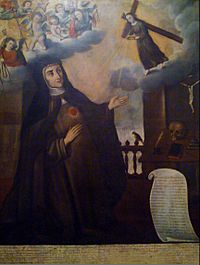Francisca Josefa de la Concepción facts for kids
Quick facts for kids
Mother
Francisca Josefa de la Concepción
OSC
|
|
|---|---|

An allegorical portrait of Sister Josefa del Castillo, c. 1813
|
|
| Born | Francisca Josefa de Castillo y Guevara 6 October 1671 Tunja, New Kingdom of Granada, Spanish Empire |
| Died | 1742 Tunja, Viceroyalty of New Granada, Spanish Empire |
| Occupation | Nun |
| Language | Spanish |
| Period | 1694—1742 |
| Subject | Christian mysticism |
| Notable works | Afectos espirituales |
|
|
|
Francisca Josefa de la Concepción (1671–1742) was a very important nun and writer from a place called the New Kingdom of Granada. This area is now known as Colombia. She was a criolla, which means she was of Spanish descent but born in the Americas.
Francisca Josefa was also a mystic, someone who had deep spiritual experiences. She was the first woman writer from what is now Colombia whose works were published. Her writings were about her faith and her own life, but they came out after she had passed away.
Many experts, like Dario Achury Valenzuela and Elisa Mújica, see her as one of the most important writers from the New Kingdom of Granada.
Early Life and Family
Francisca Josefa de Castillo y Guevara was born on October 6, 1671. Her family was wealthy and lived in Tunja, a city in the New Kingdom of Granada.
Her father, Francisco Ventura de CastiIlo y Toledo, was from Spain. He was a noble called an hidalgo. He served as a General Lieutenant and later as the Mayor of Tunja. Francisca's mother, María Guevara Niño y Rojas, was born in Tunja and had Basque family roots.
Francisca Josefa had three siblings: Catalina, Pedro Antonio Diego, and another sister whose name is not known.
Becoming a Nun
When Francisca Josefa was a young woman, she decided to become a Poor Clare nun. This meant she would live a religious life inside a convent. She joined the Royal Monastery of St. Clare in her hometown of Tunja. She stayed there for the rest of her life.
- At age 18, she entered the Convent of Santa Clara la Real.
- She spent two years as a laywoman, learning about convent life.
- Then she spent two years as a novice, preparing to become a nun.
- On September 24, 1694, at age 23, she officially became a nun. She took the name Francisca Josefa de la Concepción.
Francisca Josefa bought her own cell (a small room) in the convent. It had a special view of the chapel and also overlooked an orchard with fruit trees. Today, her cell is a place that visitors to the convent like to see.
Life in the Convent
Life in the convent was not always easy for Francisca Josefa. Some people were jealous of her intelligence. Even though she didn't have many chances to study, she managed to learn Latin and read the Bible.
Priests who were her confessors (spiritual advisors) encouraged her to write. They wanted her to record the deep spiritual feelings she experienced.
Francisca Josefa did many different jobs within her religious community:
- She was a sacristan, taking care of the church's sacred items.
- She worked as a midwife and a nurse, helping others.
- She was a novice mistress, guiding new nuns.
- She served as a listener and a secretary.
- She was elected abbess (the head of the convent) four times: in 1715, 1718, 1729, and 1738.
- She also learned to play the organ, a large musical instrument.
See also
 In Spanish: Francisca Josefa del Castillo para niños
In Spanish: Francisca Josefa del Castillo para niños
- María Josefa Acevedo Sánchez
- Juan de Castellanos Sánchez
- In Spanish: Francisca Josefa del Castillo para niños

